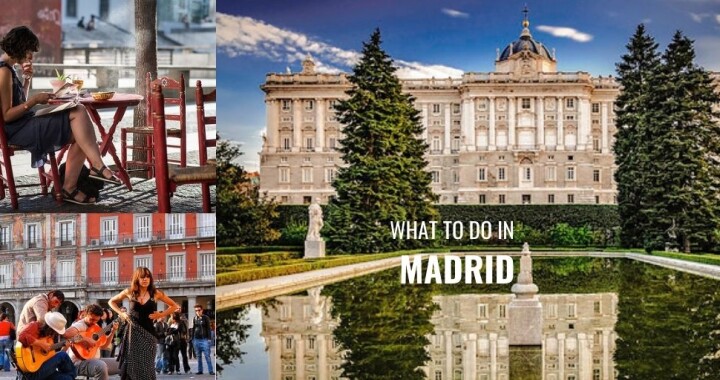We’ve been planning family and group itineraries to Spain and Portugal for decades and love the way Totally Spain clients are always wowed by Madrid. It always seems to get less attention internationally than Barcelona but we think it’s just as worthy of your precious vacation time as the Catalan capital. If you want to know what to do in Madrid, here’s what we love to see and always schedule in for our clients…
Wondering What To Do in Madrid? Read on for our 10 tips…
Although the city dates back to the ninth century, Madrid only became the capital of Spain in 1561 when Phillip II moved his court from Toledo. Four and a half centuries later and this city is a major European city destination that never fails to please.
The mainstream media loves Madrid as much as we do. The Telegraph says Madrid is “perfect for a culture-rich long weekend or city break, with great food and a lively atmosphere at night”. The New York Times praises it for its “resourcefulness, creativity and reinvention”. And National Geographic says it “offers a selection of delights so tempting it reduces even the most seasoned traveler to giddiness.”
High praise indeed! Let’s share 10 of our favourite places to experience Madrid:
1 The Golden Mile of Art Museums
We love Madrid’s museums – which are truly world-class and many are conveniently located to the Paseo del Prado boulevard. The key museums are the Prado, Reina Sofia and Thyssen-Bornemisza and their doors are all that stand between you and the masterpieces by Velazquez, El Greco, Goya and Picasso.
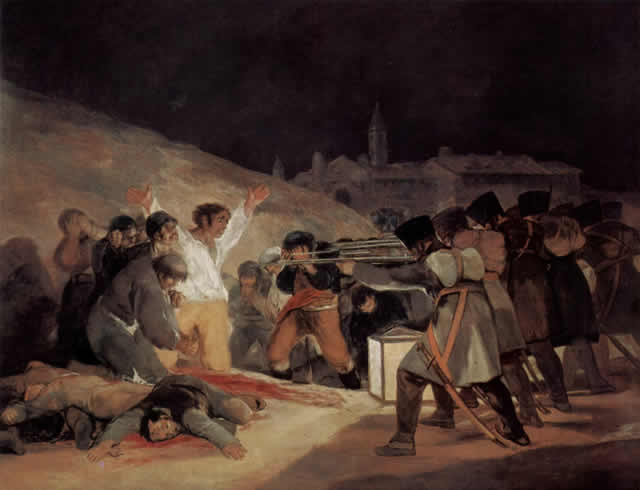
The iconic ‘Third of May’ painting by Goya in the Prado Museum. photo credit: Fabián Montojo Goya: Fusilamientos del Tres de Mayo (1814) via Flickr & Creative Commons
The best place to start is the Prado Museum that dates back to 1785 and houses art from the 12th to the 19th centuries including large permanent collections by Velazquez, Goya and Bosch. It was opened to the public in 1819 and has been drawing big crowds ever since (in 2016 it attracted 3m visitors!). We always recommend hiring a private guide to manoeuvre this vast space! See the museum’s recent video that gives an overview of the space and the principal pieces.
If the thought of a second museum fills you with dread – then let’s we’ll made a deal with you. Go to the Reina Sofia to see just this one painting (pictured below). The Guernica by Pablo Picasso is the most highly-prized pieces in this permanent collection of 20th century art. It is astonishing. It’s the type of painting that changes the way you think about art. While you are there, you’ll really enjoy the wonderful space itself and as you walk around this former hospital from the 16th century, you may find yourself tempted by the other great Spanish artists including Juan Gris, Joan Miro, Eduardo Chillida and Antoni Tapies, and of course, Salvador Dali. The works of Max Ernst, Richard Serra, Damien Hirst, George Braque and Francis Bacon are also there to lure you in. Take some time afterwards at the wonderful cafe which will help you re-connect with the real world.
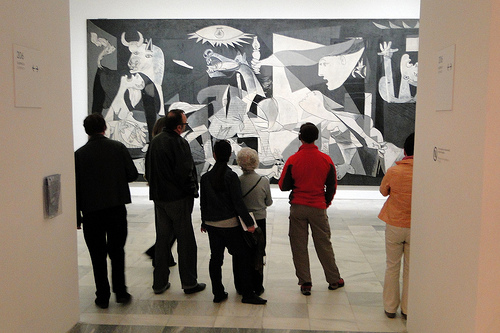
The spine-chilling Guernica by Pablo Picasso in the Reina Sofia Museum. photo credit: Adam Jones, Ph.D. – Global Photo Archive Visitors View Picasso’s Guernica – Museo Reina Sofia – Madrid, Spain via photopin (license)
If you’ve got the energy for a third art museum – we recommend a visit to the Thyssen-Bornemisza museum – the formerly private collection that was brought to Madrid 25 years ago by the Baron Thyssen’s Spanish widow, Carmen Cervera. In addition to some wonderful European pieces by Francis Bacon, Paul Klee and Paul Cezanne, we love the impressive collection of American painters such as Edward Hopper and Mark Rothko. Why visit? Although the state has purchased many of the works, it still feels like a private collection with all the quirks and personality that you expect. It’s also easy to move quickly between art movements and styles (without being exhausted) as unlike with the Reina Sofia and the Prado which fill entire rooms by a single painter, this museum might only have one work by each of the big names.
After your visit, go rest at the very pleasant Thyssen café which has a wonderful garden terrace open in the warmer months. Your feet will thank you for it! We also love the Circulo de Bellas Artes cafe and centre. A great place for a coffee, a decent menu del dia or to catch a film or an exhibition. It’s gets quite busy at night when there are queues outside for the rooftop bar and when you get there – you’ll see why – the terrace offers amazing views of the city.
2 Retiro Park
Nobody can come to Madrid and not fall in love with Retiro, the capital’s most popular park and a great place to absorb city life. When Phillip II moved his royal entourage to Madrid, he commissioned his architect, Juan Bautista de Toledo, to enlarge what had previously been a retreat into a formally laid out park. It became a real centrepiece of Hapsburg life. The gardens have since passed from royal to public property and this space is adored by Madrid’s residents of all ages. Enter the park by Puerta de Alcala designed by Francesco Sabatini in 1774 and seek out Velázquez Palace (1883) and our favourite, the Crystal Palace (1887), which is now an exhibition space run by the Reina Sofia Museum. But this park isn’t just about the buildings – it’s about the trees, the plants and the people – especially at weekends when families come in to the playgrounds and to hire one of the pedalo boats – which are great fun! You’ve also got puppet shows, and lots of other pop-up acts and activities. You may also come across literary festivals and other events that take place here.
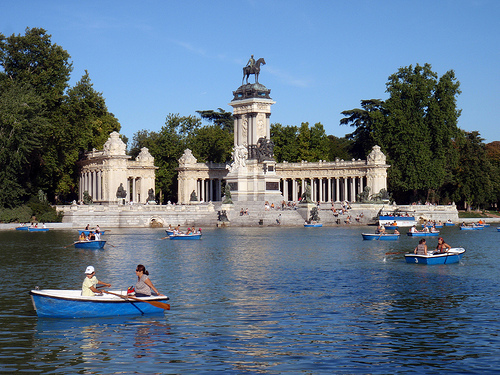
Madrid’s amazing park – make sure to take out one of the pedalo boats while you are here! photo credit: Daquella manera Retiro via photopin (license)
3 The Royal Palace
Standing on the site of a 9th century alcazar, the Royal Palace of today replaced the former palace that was destroyed in a fire in 1734. The design for the current building was devised by Italian architect Giovanni Battista Sacchetti. Building began in 1738 and was completed in 1764. Another Italian architect Francesco Sabatini (who designed the Puerta de Alcala) designed the southeast wing and the great staircase.
With 3,418 rooms there’s a lot of palace to explore. There is some debate as to its style – with experts veering between baroque and neo-classical styles. It’s best known for its painted frescos and the artwork through it pretty impressive – you’ll find paintings by Velázquez, Goya, Rubens, El Greco and Caravaggio. Plenty of great tapestries also. Historians will enjoy seeing Charles III’s bedroom designed by Sabatini and The Royal Armoury, hailed as the best European collection together with the Imperial Armoury of Vienna, which are both attributed to the Hapsburgs. Why visit? It’s like a back catalogue in interior decoration as each of the rooms represents a period in time and a style in fashion. We love the Chinese Room for its colour. And the nearby gardens are wonderful too. Because of its size, and the crowds (almost 1.5 million people visited in 2016), make sure to pre-book your tickets or book a place on our private city walking tours that includes a guided visit of the palace.
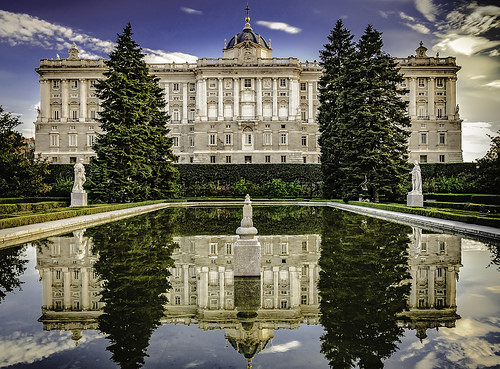
The view of the Royal Palace in Madrid from the Sabatini Gardens. photo credit: just_lightshots Royal Palace Of Madrid via photopin (license)
4 Madrid’s Plazas
We adore this city’s relaxed atmosphere and where better to experience this than in the city’s outdoor squares such as the Plaza Santa Ana, Plaza Mayor, Plaza Dos de Mayo, Plaza de la Villa and the Plaza del Oriente. Today the squares are home to the city’s festivals, fairs, theatre performances, holy week processions, street markets and café-culture. You’ll have to close your eyes and imagine the bullfights, trials and inquisition that took place in, for example, the Plaza Mayor in the past. Although these spaces are busy all day long, they are a lifeline in the heat of the Summer when the sun recedes and a cool breeze blows through. That’s when you’ll find toddlers, teenagers and the elderly swapping their air-conditioned apartments for the plazas. Do the same and sit on a bench or order a refreshing beer at one of the cafes and you’ll see why it’s the best place to be. If you are travelling in July or August, we’ve written a guide on How to Enjoy Madrid in the Summer here.
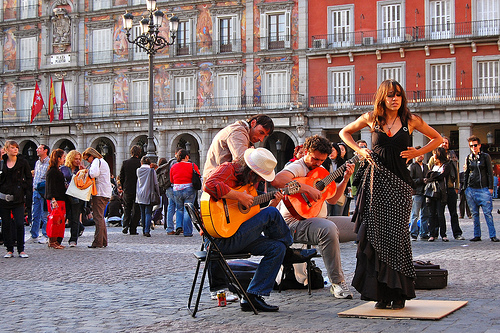
You never know what you’re going to come across in Madrid’s colourful plazas! photo credit: Allan Reyes Flamenco en Plaza Mayor via photopin (license)
5 Madrid’s Food
Because this is a capital city, not only do you get to taste some classic Madrid favourites in typical taverns, you’ll also get to sample the best regional dishes from all over Spain. Start off in style by visiting one of the city’s foodie havens such as the Mercado de la Paz in the Barrio Salamanca, the very hip Mercado de San Miguel near the Plaza Mayor and the newly refurbished Mercado de San Anton in Chueca. Browse the stalls, examine what’s on sale and get a sense for what is seasonal and on offer. That’ll help you later when you go to order from a menu!
Where do we recommend in Madrid for great food? If you’re looking for relaxed dining options, we love the streets around Santa Ana and the Cava Baja area which is great for tapas also. Bear in mind that you will need to stand in many of these establishments. For more formal dining, we always recommend trying one of the quintessential Madrid establishments such as Casa Lucio or Posada de la Villa (both on Cava Baja) and we also recommend trying some regional cuisine. How about Basque pintxos at Lamiak, again on Cava Baja or the latest offering from Cantabria, La Primera, on Gran Via, 1. We’re also big fans of rather hip and architecturally pleasing Bosco de Lobos on Calle de Hortaleza 63 (at the College of Architects HQ). It’s also a good place for drinks especially in the outdoor garden area.
If you’re new to Spanish food, perhaps you’d enjoy a private guide to take you around the markets and delis and explain some of Spain’s unmissable dishes and the art in Spanish gastronomy. Or maybe you’d like to join a gastronomy tour on one of your first days – we always recommend taking a food tour at the start of your trip to help get your bearings…
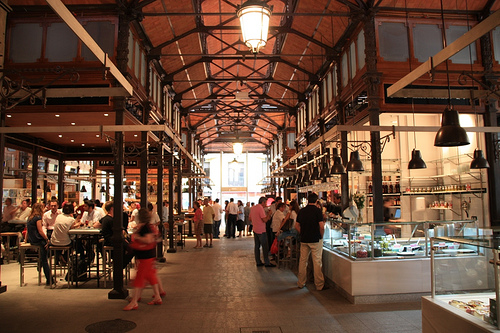
Food is an essential part of any Madrid trip and the markets are a key part to understanding how the city eats… photo credit: jlastras Zona Central del Mercado San Miguel via photopin (license)
6 Madrid’s Bars
Timing is vital when visiting bars in Madrid as each street and neighbourhood has a particular time of the day (or even day of the week) when it is busy – and there is nothing more lacklustre than an empty Spanish bar – trust us! Although it is a bit touristy, we often recommend the Santa Ana square and surroundings (especially Echegaray Street) for a midday aperitivo or an evening drink. You’ll find lots of really pleasant bars with staff that can speak English and you’ll always find a crowd– especially at the obligatory Cerveceria Alemana where Hemingway was a regular. If you want something a little less touristy but equally easy to navigate, we love the Cava Baja area which is perfect for tapas and bar-hopping. Again – remember – you will need to stand in many of these bars. It’s all about enjoying a glass of wine and something to nibble in as many places as you can manage.
If ‘art deco’ sounds more like your type of bar – then you need to look for Bar Cock on Calle Reina 14 (don’t be put off by the name – it’s actually very classy) that dates from 1921. Museo Chicote on Gran Via that dates from 1931 is another good port of call.
Those of you looking for drinks with rooftop views should check out The Roof Bar on Plaza Santa Ana and the Azotea of the Circulo de Bellas Artes. You may need to pay to access these bars – see more rooftop locations in Spain here. Another favourite of ours is La Ardosa on Colon 13, and we’re big fans of the ‘Anciano Rey de los Vinos‘ which dates from 1909 – it’s on Calle Bailen near the Almudena cathedral, and is perfect for refuelling before or after visiting the Royal Palace.
As many of these places we have mentioned are extremely popular, the bar owners don’t need to impress you with free tapas. To get those, you need to head away from the beaten track to the smaller neighbour bars. That’s where you’ll be offered a few olives, and perhaps even tripe, jamon, or the unusual ‘oreja de credo’ yes – that does mean pig’s ear which is actually ok – but we understand if you want to leave it behind. If you don’t like what being offered for free, just ask for a ‘racion’ de queso or chorizo which will set you back about 5 euro or so and helps offset the effects of alcohol so you can last until the wee hours. Check out our guide to alcohol-free drinks in Spain – which will have the same effect!
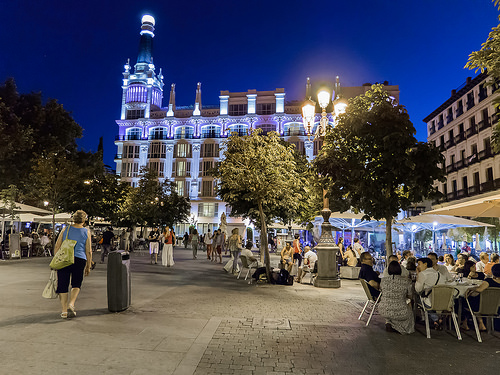
Madrid’s Plaza Santa Ana is a good place to try out a few local bars. Start at the famous Cerveceria Alemana, take in some of the smaller places in the surrounding streets and finish up back in the square at the rooftop bar… photo credit: Edgardo W. Olivera Plaza de Santa Ana, Madrid via photopin (license)
7 Madrid’s Cafes
Madrid is home to a dazzling array of cafes open from very early to impossibly late. We always encourage our clients to check out the cafes and bars on the street where they are staying especially when they haven’t chosen a buffet breakfast. For the princely sum of 3 euros, you can usually find a great coffee deal including a barista quality coffee, fresh juice and a croissant – all enjoyed in the company of Madrid’s office workers, dog walkers and fellow-travellers.
If you want to take in some of the city’s best known cafes for a session of serious people watching, we always steer our clients towards the Paseo de Recoletos (near Cibeles) where you can choose between the old-world charm of Café del Espejo and Café Gijon. Both are great for a jolt of coffee in historic surroundings. We also like them for a vermouth with olives before lunch or a refreshing after-museum drink too. Café Gijon dates from 1888 and has been long connected with Madrid’s literary and art scene. It’s a bit pricey for food but perfect for people watching if you have time to kill. Café del Espejo is also perfect for whiling away a bit of time after the museums and if you are peckish, you’ll be able to pick up something light to tide you over.
Closer to the Puerta del Sol, we are also big fans of the Café del Principe on Plaza de Canalejas. This cafe also serves food including Madrid’s ‘cocido’ which is a chickpea based meat stew. It’s a handy place to meet after shopping on Calle Preciados or before going out in Santa Ana.
Another of the city’s best known cafes is the Cafe del Oriente – in the Plaza of the same name. It’s a handy place to rest after visiting the Royal Palace and the views from the outdoor terrace are hard to beat. The food can seem a bit pricey but when you add in a live jazz performance (check before booking) and a chef who can cater for dietary requirements such as kosher, you know you are in safe hands. You can occasionally find meals deals for here on El Tenedor.
One of Madrid’s most famous spots is Chocolateria San Gines which was established in 1894. It’s known for its hot chocolate and churros and is open 24 x 7 265 days of the year so there’s really no excuse for you not trying it out. Don’t be surprised to find it busy at 1 or 2 am when people who have met up for a few drinks often pop in for something sweet before heading home.

You’ll find lots of Madrid’s cafes serving beer and its bars serving coffee wherever you go! Make sure you take some time to enjoy both in the city. photo credit: fernando garcía redondo Terraza al museo via photopin (license)
8 Madrid’s Neighbourhoods
It’s easy to stick to the very centre of Madrid such as Las Austrias and Sol/Gran Via but we recommend getting around to the other neighbourhoods known as barrios. The well-heeled side of Madrid is best observed in the barrio Salamanca which is where many of the hotels and the posher shops can be found. The Barrio de las Letras which lies behind the Thyssen Museum makes for a very pleasant afternoon wander – look for the Calle Huertas and its side streets including the Lope de Vega house museum on Calle Cervantes and Cervantes burial place in the Convent of the Barefoot Trinitarians on Calle Lope de Vega! Chueca is where you’ll find the LGBT friendly side of town with lots of independent shops and cool bistros and bars along the side streets. You’ll also find the high-street premium branded stores on the pedestrianised section of Calle Hortaleza. We’ve written quite a bit about the Calle Cava Baja – that’s in the neighbourhood of La Latina where you’ll also find the flea market known as the Rastro (please beware of pickpockets here and in the Sol neighbourhood.) We’re not huge fans of the Rastro but you will find some nice antique stores in the streets surrounding the flea-market. We like Galerias Piquer on Calle Ribera de Curtidores 29. If you’d like us to find a private guide to show you some of Madrid’s barrios, let us know. We work with the best in the capital.
9 Madrid’s House Museums & Other Niche Museums & Spaces
If you’ve had a day to recover from the big three comprising of the Prado, Reina Sofia and the Thyssen, there are lots of niche museums also worth checking out. We’ve already written about the painter Sorolla’s House-Museum which we adore. And the Cerralbo House-Museum which gives a snapshot of what aristocratic life was like back in the late 19th century. Another popular house-museum is the Lazaro Galdiano House Museum which has some excellent Goya drawings plus a very pleasant garden also.
We also love the Railway Museum – a fantastic museum for families as children adore being able to go inside the old carriages. The Decorative Arts Museum is well worth visiting. There you’ll get to see Philip V’s writing desk and other items of furniture and decoration including goblets, vases, carpets, tiles and even pistols. The Caixa-Forum is interesting from a landscaping point of view as well as artistic. The Costume Museum (Museo del Traje) is another interesting space with exhibits covering Royal clothing, folk costumes, jewellery and all the major Spanish designers including Fortuny, Balenciaga & Pertegaz. We can help match up your interests with Madrid’s smaller museums and advise whether the audio tours or group tours are worth taking.
If you prefer the great outdoors, the Botanic Gardens are well worth a visit. Dating back to 1755, the gardens are very conveniently located beside the Prado Museum. We’ve visited in all seasons and love the variety each season brings! You’ll adore these 8 hectares of beautifully tranquil gardens that offer a great retreat from the busy city centre. In terms of trees, you’ll find yew, pine, elm, hackberry, cypress, pomegranate, linden, copper beech, oak and cedar. You’ll also like enjoy the bonsai collection, the Olive Tree Avenue, the rose gardens, and the cacti in the Greenhouse Exhibition. For more, see our post on Gardens in Spain.
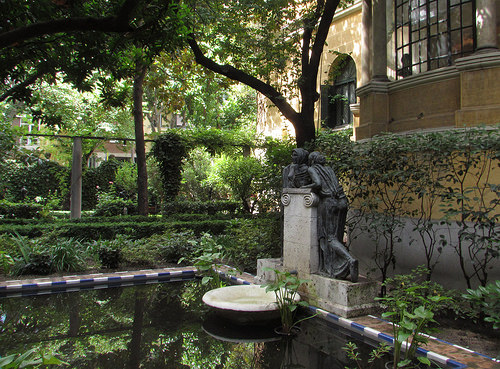
House-museums are a great way to learn about the city in very comfortable surroundings! photo credit: chericbaker Sorolla garden via photopin (license)
10 Experiences
If you’ve been to Madrid before or have quite a few days to spend here, why not try something completely different. If you’ve been pounding the pavement or exploring all the museums, why not try out the Hamman baths. We love the swimming pools, hot baths and relaxing massages. If you don’t have time in Madrid but are travelling around Andalusia, you can also enjoy these Hammam baths in Granada, Cordoba and Malaga.
For football fans, Madrid means only one thing – Real Madrid. Getting tickets can be tricky but we have been known to work miracles. If you don’t coincide with a game, you can still tour the Bernabeu Stadium and see the pitch, press room and dressing rooms when your favourite player hangs out. The museum is excellent especially for younger visitors and those who are usually averse to museums – as they can enjoy seeing the winning cups and trophies in a very interactive and modern environment.
Perhaps a cooking class is more your style? We can tag on a cooking course to a food market tour so you can learn to prepare some of Spain’s best known tapas such as Spanish tortilla, gazpacho, paella, prawns in garlic and churros with chocolate. You can even enjoy a wine-tasting as you help prepare the dishes in a lovely informal atmosphere where you’ll come away with lots of culinary knowledge as well as recipes and know how to try out at home.
And finally, although it’s not exactly near the South of Spain, Madrid is a great place to see a flamenco show as many of the top artists work from here. You’ll find up to a dozen places offering flamenco shows although we obviously have our favourites. If you want to make a day of it, we can arrange for you to take a flamenco class in the morning and that evening you can attend a show – and appreciate the skills and tradition even more.
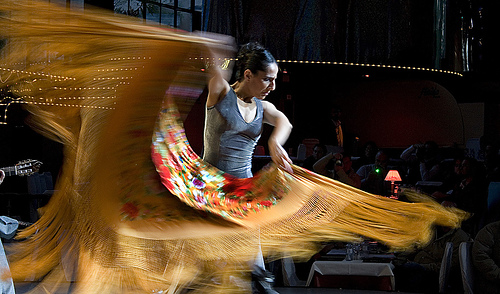
Be transported to a different place and time in the amazing flamenco shows in Madrid. photo credit: aiscube Flamenco via photopin (license)
Have some more time left? We’ve also written about 10 Best Destinations for Day Trips from Madrid including El Escorial, Toledo, Chinchon, Salamanca, Cuenca, Segovia, Aranjuez, Avila, Alcala de Henares, and the Ribera del Duero wine region. We can provide a private driver to collect you from your hotel and connect up with a private guide at any of these locations. You can also whisk you away for a night or two with a private driver and guide to the Rioja and the Rioja Alavesa wine regions. Or you can jump on the high-speed train to Seville, Cordoba and Valencia.
